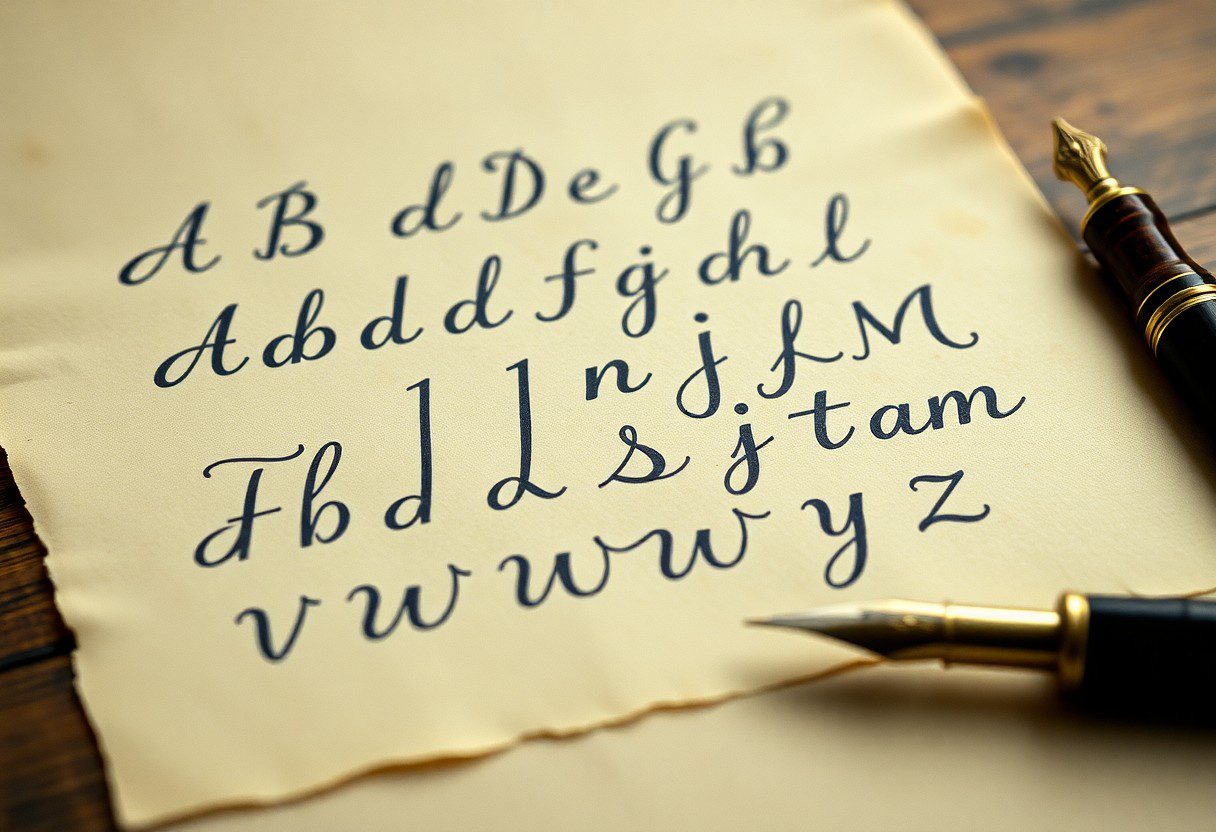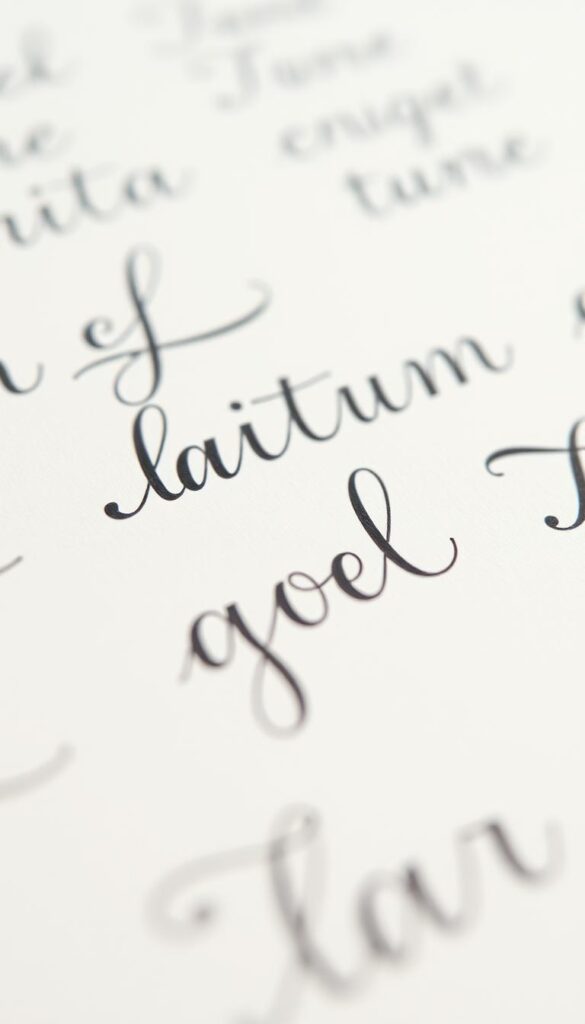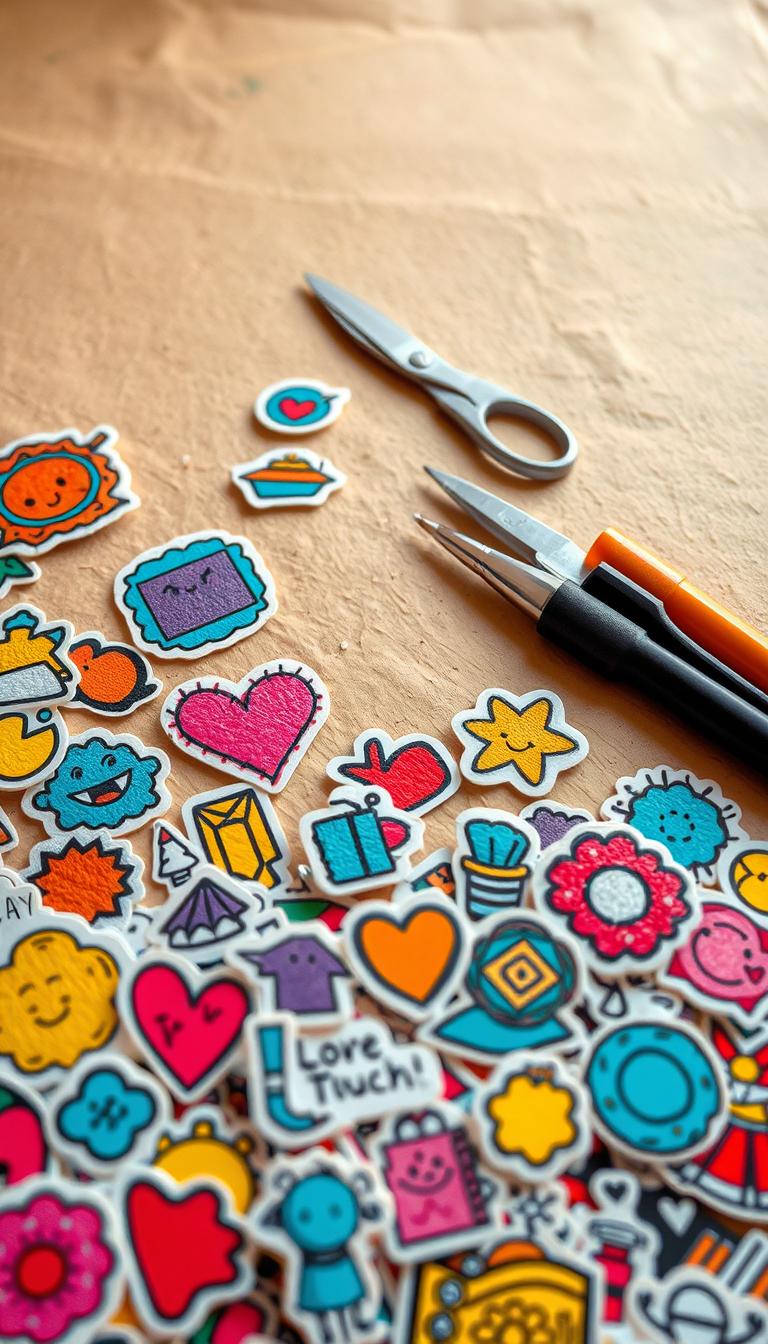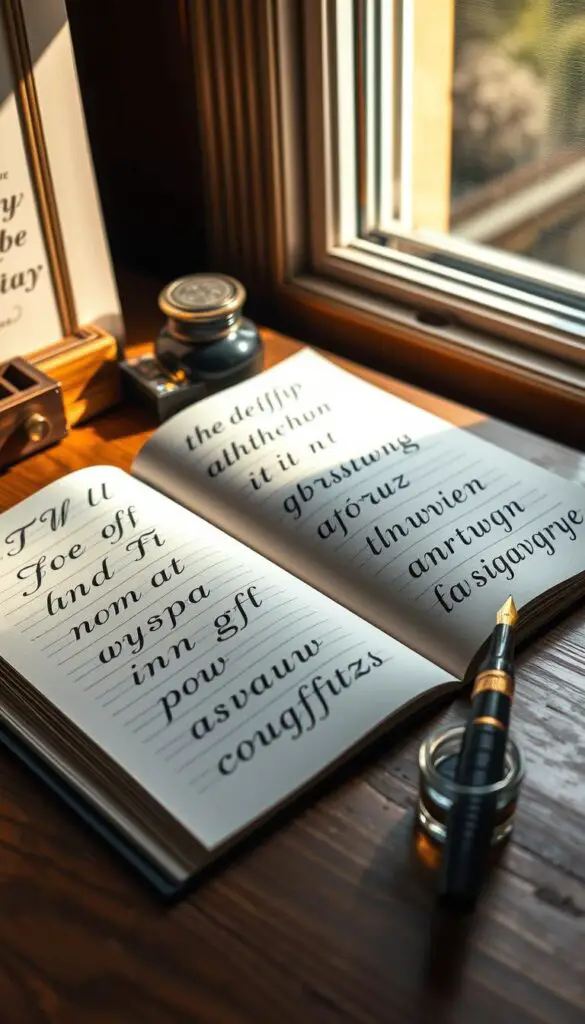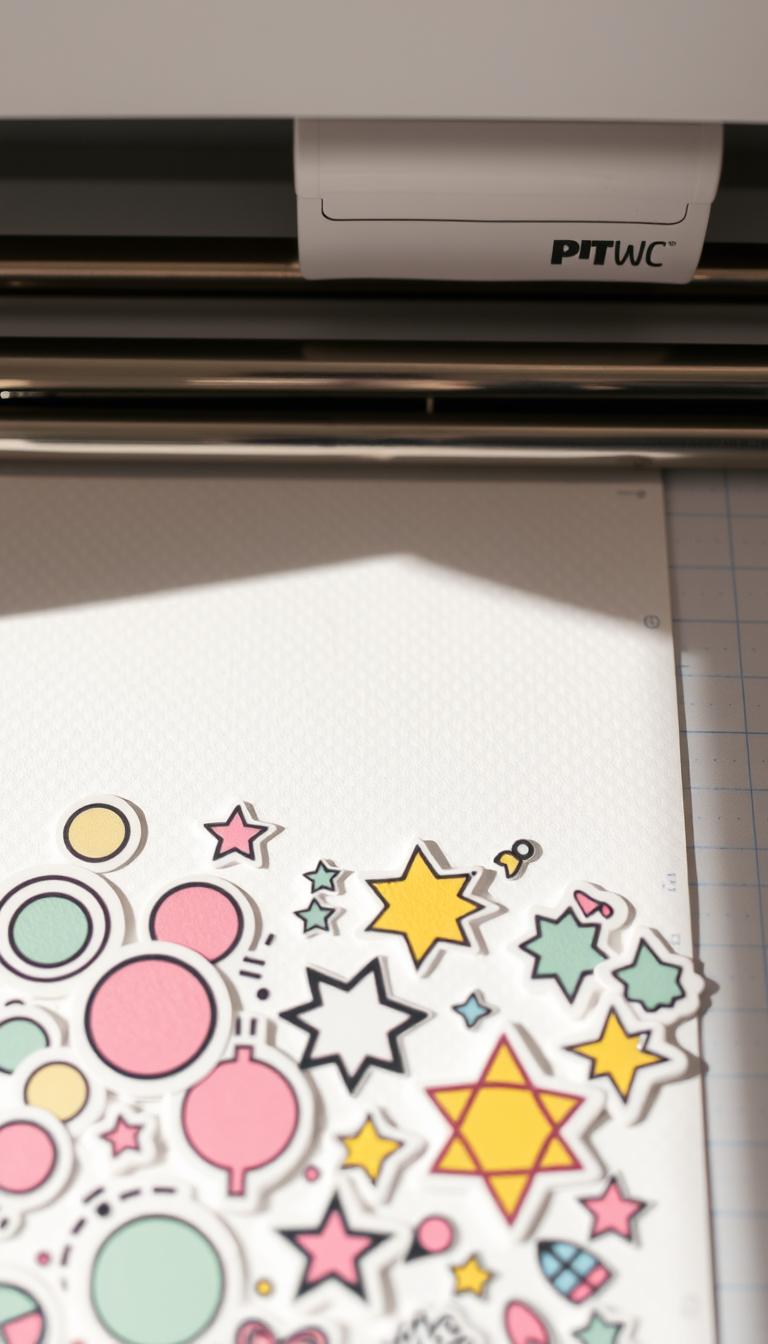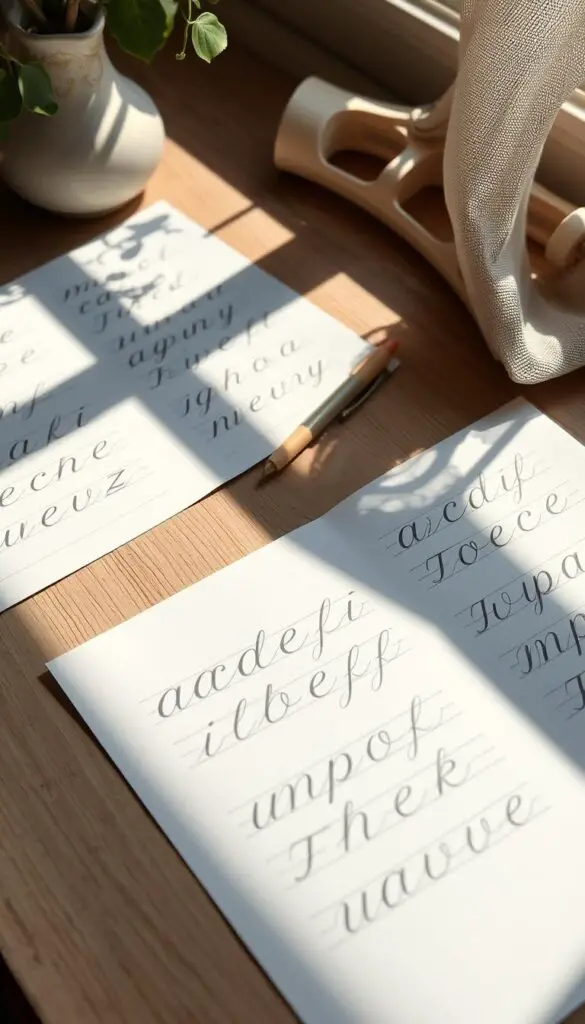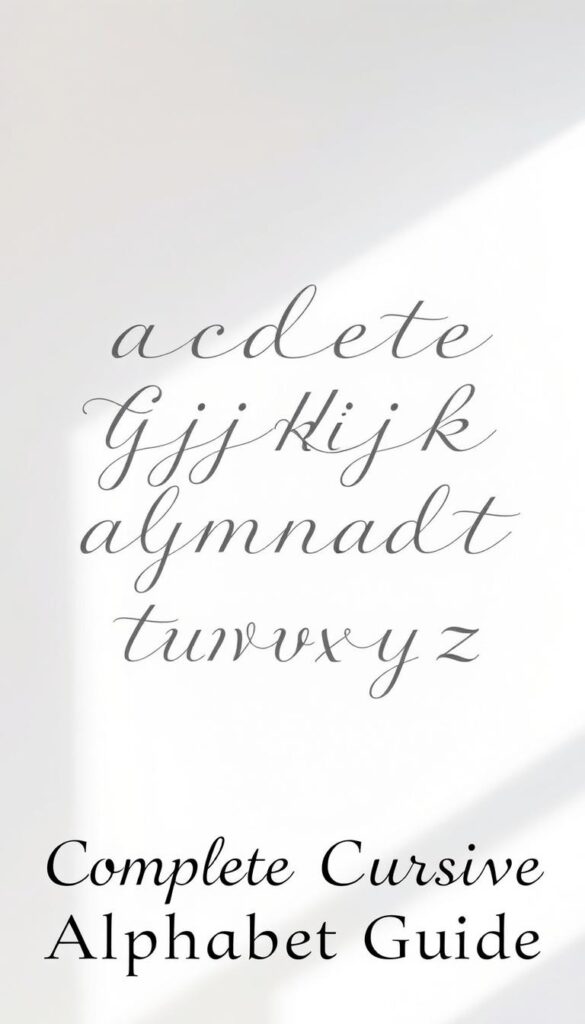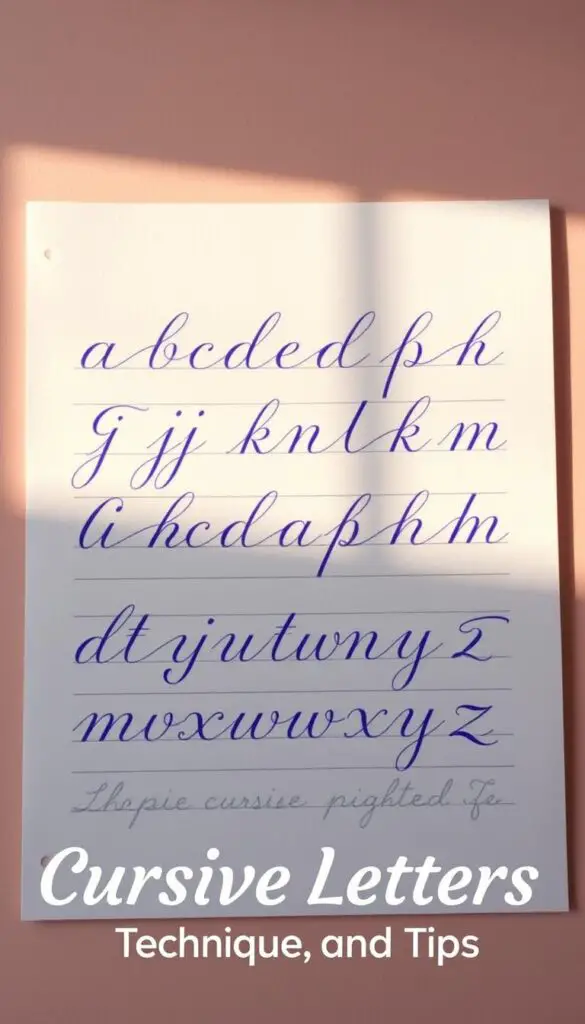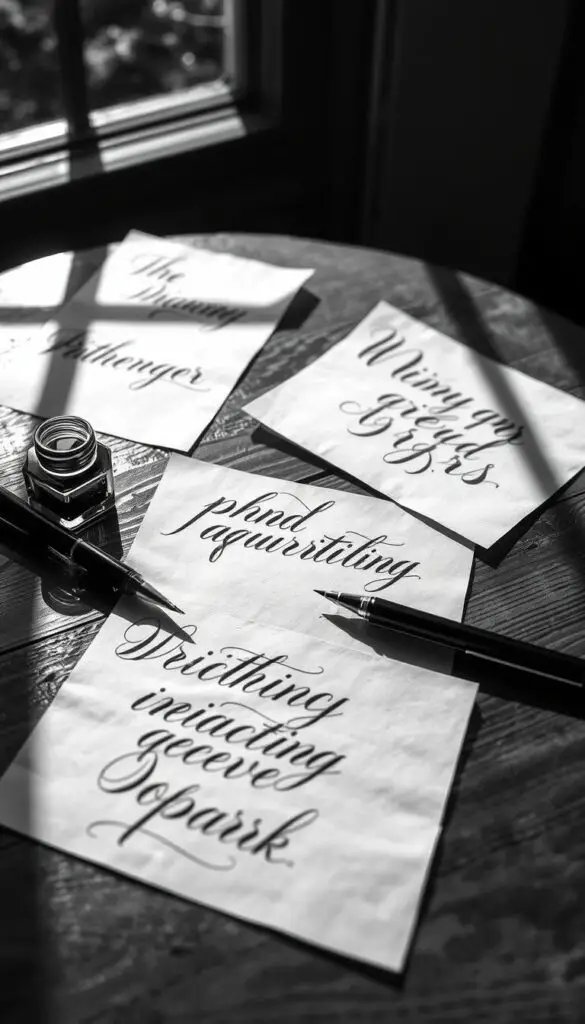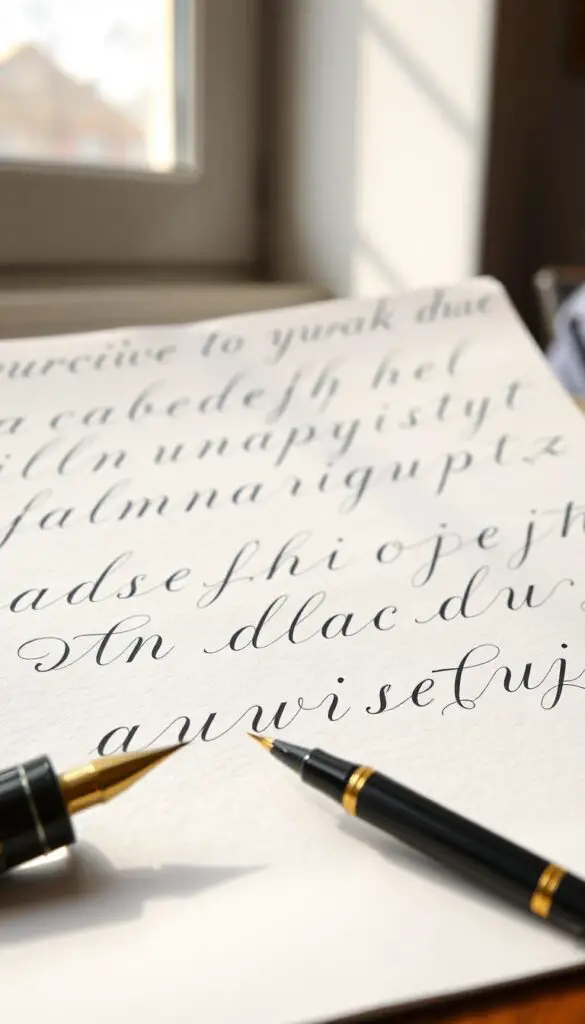About 75% of Americans use cursive writing every day. This shows how important the cursive alphabet is in our culture. The cursive alphabet has 26 letters that flow together, making it a special way to write.
It has a long history and adds beauty to writing. Learning cursive is key for those who love script and want to improve their handwriting.
Mastering cursive can make your handwriting better and more personal. It also lets you see the beauty of script. In this article, we’ll explore cursive writing’s history, benefits, and uses. We’ll give you a detailed guide on cursive letters and how to practice.
The History and Evolution of Cursive Writing
Cursive writing has a long history, starting over 2,000 years ago in ancient Rome. The art of handwriting has changed a lot over time. Different styles and scripts have come and gone. To write cursive letters, you need to practice a lot, starting with the alphabet, including the letter z.
In the United States, cursive was once a key part of school. In the 19th century, many schools taught the Spencerian method. But with the growth of technology, cursive writing became less common in the 20th century. Yet, many teachers and experts believe it’s important for learning and remembering things.
Now, there’s a new interest in cursive writing. Many schools and teachers are adding it back into their lessons. With workbooks and online tools, students can learn and improve their cursive skills. They can start with simple letters and move on to more complex ones.
Understanding the Basic Structure of Cursive Letters
Cursive letters are made from simple strokes like curves, loops, and slants. To get good at cursive writing, knowing the basic structure is key. The script alphabet has different letterforms grouped by shape. For example, the CursiveLogic method teaches letters with similar shapes together, making learning easier and proper formation possible.
Handwriting practice is vital for mastering cursive. Regular practice builds muscle memory, helping form letters right. Fancy handwriting and calligraphy alphabet add an artistic flair to cursive. Start with the basics, like learning strokes and letterforms, to begin cursive writing.
- Begin with simple strokes and then move to more complex letters
- Practice often to build muscle memory
- Pay attention to proper letter formation and how letters connect
By following these tips and spending time on handwriting practice, you can master cursive writing. You’ll develop a unique and elegant script alphabet.
Essential Tools for Learning Cursive Alphabet
To master the cursive alphabet, you need the right tools. The quality of your writing instruments, paper, and practice materials matters a lot. For example, a pen with good grip and ink flow helps write smooth cursive letters. Paper with guidelines helps keep letters the right size and spaced correctly, which is key for good handwriting.
Choosing the right writing instrument is important. You can pick from fountain pens, rollerball pens, or pencils. Each has its own benefits. Fountain pens are good for smooth lines, while rollerball pens offer a fluid writing experience. Cursive writing needs precision and control, so pick what feels right in your hand.
The type of paper you use also affects your handwriting. Paper with guidelines helps keep letters even, which is vital for good handwriting. There are many papers to choose from, like lined, graph, or plain paper. The best one for you depends on your preference and the practice you’re doing. For example, lined paper is perfect for cursive, while graph paper is better for worksheets.
Some key tools for learning cursive include:
- Cursive handwriting worksheets
- Guided paper with dotted lines
- A pen or pencil with good grip and ink flow
- A comfortable and ergonomic writing surface
With the right tools and materials, you can improve your cursive writing. This includes practicing cursive letters and overall handwriting. It’s a critical part of learning, even in early grade levels.
Mastering Lowercase Cursive Letters
Learning lowercase cursive letters is key for writing in cursive. It lays the groundwork for more complex words. With 26 letters to practice, from a to z, you can boost your handwriting. Regular handwriting practice is essential to get better at cursive.
The script alphabet is a core part of cursive writing. Mastering lowercase letters is important for a beautiful fancy handwriting style. By practicing, you can create your own calligraphy alphabet for writing, art, or signing.
To get good at lowercase cursive, start with basic strokes like curves and loops. Then, move on to more complex letters. With handwriting practice, you’ll improve your cursive and develop a unique style.
Mastering lowercase cursive has many benefits. It improves hand-eye coordination and helps you remember things better. By using cursive letters in your daily writing, you’ll see these benefits and create beautiful handwriting.
The Complete Cursive Alphabet Guide
Cursive writing is elegant and expressive. Mastering the cursive alphabet is key for beautiful handwriting. It has 26 uppercase and 26 lowercase letters, making 52 unique forms for practice. Regular handwriting practice boosts writing fluency and quality.
Research shows cursive writing improves hand control. It makes writing 25% faster than print writing. Daily practice of cursive letters for 15 minutes can enhance handwriting quality in 2 weeks.
Basic Strokes and Connections
Cursive letters have 3 to 5 distinct strokes. Mastering each letter takes 5 to 10 repetitions. Knowing the basic strokes and connections is vital for mastering the cursive alphabet.
Letter Formation Rules
Understanding the rules for forming letters is essential. This includes the correct order of strokes, connections between letters, and script alphabet techniques.
| Letter | Number of Strokes | Repetitions for Mastery |
|---|---|---|
| A | 3 | 5 |
| B | 4 | 7 |
| C | 3 | 5 |
By following these guidelines and practicing regularly, you can master the cursive alphabet. This will improve your cursive writing skills.
Uppercase Cursive Letters: Techniques and Tips
Learning uppercase cursive letters is key for better handwriting practice. It makes writing smoother and more organized. Uppercase letters are used less, but with practice, you can get better at them.
The script alphabet has many uppercase letters, each with its own way of being written. For example, D, F, and T start with a downward stroke. On the other hand, A, C, E, O, and Q start with a right curve. Knowing these techniques is important for fancy handwriting and calligraphy alphabet skills.
Improving your uppercase cursive writing takes regular practice. Using bold lines and transfer paper can help. These methods improve your fine motor skills and make your writing clearer and faster. Learning uppercase cursive is important for creating your own writing style, which is essential for writing well beyond second grade.
Adding uppercase cursive letters to your daily handwriting practice can boost your writing skills. It can make your writing faster, smoother, and more organized. With hard work and practice, you can become great at uppercase cursive writing, making communication easier and more effective.
Connecting Letters in Cursive Writing
Cursive writing is faster than the fastest printed writing. It shows how important it is to connect letters for speed. To get good at cursive, you need to know the basic connection rules and practice often. Regular practice helps keep your writing smooth and flowing.
When you connect letters in cursive, each letter has its own special needs. For example, letters like b, v, and o need a special connector. Letters that you have to go back over, like a, c, and d, can be harder to link together.
To get better at cursive, try flow exercises and use a workbook. Start with small groups of 2 to 3 letters to build your motor plan. Writing cursive every day can make your writing faster, better, and more memorable. Just 15 minutes a day can make a big difference.
Some good things about cursive writing are:
- Improved hand control and fine motor skills
- Enhanced memory retention and writing speed
- Increased creativity and personal style in writing
- Reduced writing-related stress levels
By following these tips and practicing often, you can master connecting letters in cursive. This skill is useful for everyday writing or for artistic projects. The secret to beautiful handwriting is consistent practice and a desire to learn and get better.
Special Characters and Numbers in Cursive
Cursive writing is more than just letters. It also includes special characters and numbers. Learning these is key for fancy handwriting and calligraphy alphabet. With regular handwriting practice, you can get better at writing these in cursive.
Some special characters, like @, &, and $, have their own cursive letters. Numbers in cursive, such as 1, 2, and 3, also have unique script alphabet styles. To master these, practice often and use the right handwriting practice methods.
Here are some tips for writing special characters and numbers in cursive:
- Start with the basics: Begin with simple characters and numbers, and gradually move on to more complex ones.
- Practice regularly: Consistent handwriting practice is key to mastering special characters and numbers in cursive.
- Use the correct techniques: Pay attention to the correct script alphabet styles and techniques for each character and number.
By following these tips and practicing regularly, you can improve your skills in writing special characters and numbers in cursive. This will also enhance your overall fancy handwriting and calligraphy alphabet skills.
Developing Your Personal Cursive Style
As you keep practicing cursive writing, you’ll start to create your own style. This is a thrilling part of the journey. It lets you show your personality through your cursive letters. To find your rhythm, try writing at different speeds and with varying pressures.
Also, experiment with different writing tools. Try using a 0.5 or 0.7mm mechanical pencil or gel pens. See which one feels most natural for you.
Adding artistic touches to your cursive alphabet can also enhance your style. Think about adding flourishes like loops and curves to your letters. You can also play with letter spacing and slant to make your writing stand out.
For inspiration, check out Pinterest and Instagram. These platforms are full of cursive fonts and styles to admire.
To improve your script alphabet, make handwriting a daily habit. Even 10-15 minutes a day can significantly boost your skills. Use lined or grid paper to keep your letters even.
Practice writing at a steady pace to enhance your flow. With consistent effort and patience, you’ll develop a beautiful, unique cursive style that showcases your personality.
Practice Techniques for Cursive Mastery
Mastering cursive letters needs regular handwriting practice and review. Spend at least 20 minutes each day practicing. Start with simple letters like ‘u’ and move to harder ones like ‘a’ and ‘g’.
A script alphabet guide helps learn letter formation and connections. Using lined paper keeps letters aligned and neat. For fancy handwriting or calligraphy alphabet, more practice and patience are needed.
Regular handwriting practice boosts memory and academic scores. It also helps with dyslexia. Cursive writing makes your writing look more mature and professional, valued in American culture.
- Start with short practice sessions and gradually increase duration
- Use a variety of writing instruments and paper types to find what works best
- Practice regularly, even if it’s just for a few minutes each day
By following these tips and dedicating time tocursive letterspractice, you can master it. Enjoy the many benefits that come with it.
Digital Resources and Apps for Cursive Learning
As schools focus less on cursive, digital tools have become key for learning. Apps and websites offer interactive lessons and practice exercises. They help people learn the cursive alphabet, which is part of the script alphabet.
Some top apps for learning cursive include:
- Cursive Writing: offers a better layout and user experience
- ABC Cursive: provides uppercase letters in its free edition, but limits the full learning experience
- Cursive Words: offers ample screen space, but contains ads
For a deeper learning experience, online handwriting lessons are available. They teach D’Nealian and Zaner-Bloser fonts with step-by-step guides and videos. This makes practice more fun and effective.
Using digital tools with traditional methods helps build a strong skill set. It includes animations, guided strokes, and instant feedback. This way, people can improve their literacy and handwriting skills for life. With the right apps, anyone can master cursive and enhance their handwriting.
Common Challenges and Solutions in Cursive Writing
Many people struggle with cursive writing. One big challenge is learning cursive letters and how to connect them smoothly. Regular handwriting practice helps build muscle memory and improves your skills.
Another hurdle is switching from print to cursive script alphabet. It’s different. Start with the basics and slowly get better at more complex letters and connections. Even fancy handwriting and calligraphy alphabet can seem tough, but with time, you can get the hang of it.
Some common challenges and solutions in cursive writing include:
- Difficulty with letter formation: Practice individual letters and focus on correct stroke order.
- Connecting letters: Start with simple connections and gradually move on to more complex ones.
- Speed and legibility: Practice writing at a comfortable pace and focus on maintaining legibility.
Knowing these challenges and solutions can help you get better at cursive writing. With regular handwriting practice and focus on cursive letters and connections, you can master cursive writing.
Conclusion: Your Journey to Beautiful Cursive Handwriting
As you finish mastering the cursive alphabet, enjoy its timeless beauty and expressiveness. Regular practice in cursive writing boosts your understanding of words. It also improves your brain’s engagement and spelling skills.
Studies show that cursive letters make you more engaged. This is because you get to develop your own writing style. Keep practicing your cursive to keep your skills sharp.
Set aside a few minutes each day to work on your cursive. This will help you keep your script looking great. With hard work, your cursive will become a beautiful part of who you are. Let your cursive writing make your writing stand out in a special way.
FAQ
What is the cursive alphabet and why is it important in writing?
The cursive alphabet is a style of handwriting where letters flow together. It has a rich history and makes writing look more elegant. It also helps improve your handwriting skills.
What is the history and evolution of cursive writing?
Cursive writing started in ancient Rome and has changed over time. It’s important in education and for better handwriting. Different styles, like looped and italic, have emerged through history.
How is the basic structure of cursive letters formed?
Cursive letters use different strokes. Learning these strokes is key to mastering cursive. Regular practice helps you get better at forming cursive letters.
What are the essential tools for learning the cursive alphabet?
You need the right tools to learn cursive. This includes good writing instruments and paper. Practice materials like workbooks are also helpful.
How do I master lowercase cursive letters?
To master lowercase cursive, learn their unique features and practice a lot. Knowing how to form different lowercase cursive letters is important for good handwriting.
What is the complete guide to the cursive alphabet?
The complete guide covers the basics of cursive writing. It teaches the strokes and connections used. It also shows how to form letters correctly and avoid mistakes.
What are the techniques and tips for writing uppercase cursive letters?
To write uppercase cursive well, learn their special features and practice. Knowing the different types of uppercase cursive letters is key to a good cursive style.
How do I connect letters in cursive writing?
Connecting letters in cursive needs practice and follows basic rules. Learning the connection techniques and practicing can make your cursive writing smooth.
How do I write special characters and numbers in cursive?
Writing special characters and numbers in cursive needs specific techniques. Learning their unique features and practicing their formation is important for mastering cursive.
How can I develop my personal cursive style?
To develop your cursive style, find your flow and add artistic touches. Try different techniques and get inspiration from various styles to make your handwriting unique.
What are the practice techniques for achieving cursive mastery?
To master cursive, practice regularly and review often. Use different practice techniques, like repetition and timed practice, to improve and keep your skills sharp.
What digital resources and apps are available for learning cursive?
Many digital tools and apps can help you learn cursive. Look for online tutorials, interactive platforms, and printable sheets to enhance your practice.
What are the common challenges and solutions in cursive writing?
Cursive writing can be tricky, with challenges like letter formation and connections. Knowing these issues and how to solve them can help you improve your cursive skills.
Q: What is the cursive alphabet and how can I learn to write cursive?
A: The cursive alphabet is a style of handwriting where letters are connected in a flowing manner. To learn to write cursive, you can explore various resources, including workbooks, online tutorials, and practice worksheets that focus on each letter and its connections.
Q: Why is cursive writing still taught in schools today?
A: Cursive writing is still taught in schools today because it helps develop fine motor skills, enhances penmanship, and supports cognitive development. It also allows students to write more quickly and fluidly, which can be beneficial for note-taking during lessons.
Q: How can I improve my cursive writing confidence?
A: To improve your cursive writing confidence, practice regularly using high-quality writing materials. Focus on the fundamentals of letter formation, spacing, and connection between letters. Seeking feedback from teachers or peers can also help you identify areas for improvement.
Q: What are some common mistakes to avoid when writing in cursive?
A: Common mistakes in cursive writing include inconsistent letter sizes, improper spacing, and failing to connect letters smoothly. To avoid these, practice each letter individually and pay attention to your posture and grip on the pen to ensure legibility.
Q: How do item specifics relate to cursive writing resources?
A: Item specifics for cursive writing resources, such as workbooks or software, can help customers identify the best materials for their needs. When shopping for cursive writing items, look for detailed descriptions that indicate the quality and suitability for your skill level.
Q: Can I find cursive writing resources that are eligible for fast shipping?
A: Yes, many sellers provide cursive writing resources that are eligible for fast shipping. When you view a seller’s listing for full details, check for shipping options and estimated delivery times to ensure you receive your materials quickly.
Q: What should I look for in a cursive writing workbook?
A: When selecting a cursive writing workbook, look for items that include clear instructions, practice pages for each letter, and exercises that gradually increase in complexity. High-quality workbooks often include visual aids to help you understand letter formation better.
Q: How can seller feedback help me choose cursive writing resources?
A: Seller feedback provides insights from previous customers regarding the quality and effectiveness of cursive writing resources. By reviewing feedback, you can make informed decisions and shop with confidence, knowing that the item specifics meet your expectations.
Q: What are related searches for cursive writing that can help me find more resources?
A: Related searches for cursive writing may include terms like “cursive practice sheets,” “learn cursive online,” or “cursive writing fonts.” These searches can lead you to a variety of resources, helping you enhance your cursive writing skills effectively.
